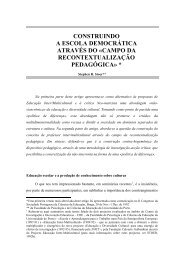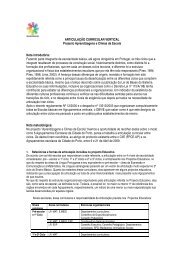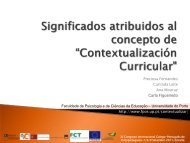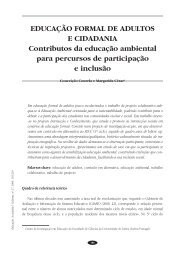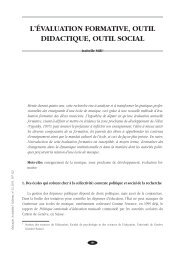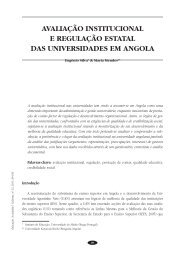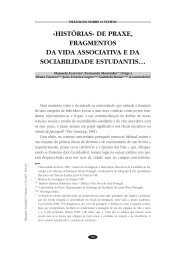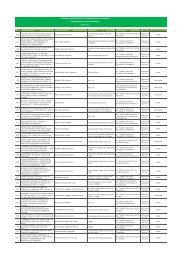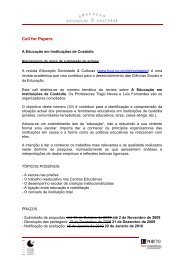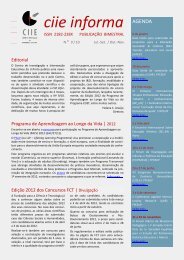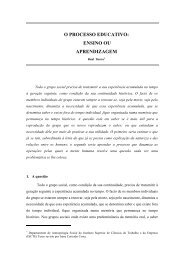REFLECTINGON AN ACADEMIC PRACTICE TOBOOST GENDER ...
REFLECTINGON AN ACADEMIC PRACTICE TOBOOST GENDER ...
REFLECTINGON AN ACADEMIC PRACTICE TOBOOST GENDER ...
Create successful ePaper yourself
Turn your PDF publications into a flip-book with our unique Google optimized e-Paper software.
Naples Nancy, & Bojar Karen (Coords.) (2002). Teaching feminist activism: Strategies from the field. NewYork, London: Routledge.Real Academia Española (RAE) (2004). Informe de la real academia española sobre la expresión violencia degénero. Retrieved April 23, 2010, from http://www.rae.es/rae/gestores/gespub000001.nsf/%28voanexos%29/archbb81f7452a4355c0c12571f000438e7a/$file/violenciadeg%c3%a9nero.htm#nota5Rebollo-Catalán, Maria. A., Pérez-García, Rafael, Piedra, Joaquín, & Vega, Luisa (2011). Diagnóstico de la culturade género en educación: Actitudes del profesorado hacia la igualdad. Revista de Educación, 355, 521-546.Riera, Josep M., & Valenciano, Elena (1991). Las mujeres de los 90: El largo trayecto de las jóvenes hacia suemancipación. Madrid: Morata.Riley, Sarah (2001). Maintaining power: Male constructions of «feminist» and «feminist values». Feminism &Psychology, 11(1), 55-78.Romero-Díaz, Alfonso, & Abril-Morales, Paco (2008). Género y la formación del profesorado en los estudiosde educación infantil. REIFOP, 11(3), 43-51.Rutherford, Alexandra, Capdevilla, Rose, Undurti, Vindhya, & Palmary, Ingrid (2011). Feminisms and psychologies:Multiple meanings, diverse practices, and forging possibilities in an age of globalization. InAlexandra Rutherford, Rose Capdevilla, Vindhya Undurti & Ingrid Palmary (Eds.), Handbook of internationalfeminisms, international and cultural Psychology (pp. 3-14). New York: Springer.Sales, Maria Luisa (2008). Jo, ni més, ni menys: Assertivitat per a força dones i alguns homes. Barcelona:Octaedro.Sánchez-Bello, Ana (2002). El androcentrismo científico: El obstáculo para la igualdad de género en laescuela actual. Educar, 29, 91-102.Sarasúa, Carmen (2002). Aprendiendo a ser mujeres: Las escuelas de niñas en la España del siglo XIX.Cuadernos de Historia Contemporánea, 24, 281-297.Schwalbe, Michael, Godwin, Sandra, Holden, Daphne, Schrock, Douglas, Thompson, Shealy, & Wolkomir,Michele (2000). Generic processes in the reproduction of inequality: An interactionistanalysis. SocialForces, 79(2), 419-52.Serrano, Marta Luxán, & Biglia, Barbara (2011). Pedagogía cyberfeminísta: Entre utopía y realidades. RevistaTeoría de la Educación: Educación y Cultura en la Sociedad de la Información, 12(2), 149-183.Shrewsbury, Carolyn (1993). What is feminist pedagogy?. Women’s Studies Quarterly, 3(4), 8-16.Siann, Gerda, Wilkinson, Helen, & Riley, Sarah (1995, July). New men, wild men and the backlash. Paperpresented at First International Multidisciplinary Congress on Men, Ottawa, Canada.Simón, Elena Rodríguez (2008). Hijas de la igualdad, herederas de injusticias. Madrid: Narcea.Smith, Mark K. (1996). «Action research»: The encyclopedia of informal education. Retrieved October 14, 2010from www.infed.org/research/b-actres.htmStaggenborg, Suzanne, & Taylor, Verta (2005). Whatever happened to the women’s movement?. Mobilization:An International Journal, 10(1), 37-52.Titus, Jordan J. (2000). Engaging student resistance to feminism: «How is this stuff going to make us betterteachers?». Gender and Education, 12(1), 21-37.Touraine, Alain (2007). El mundo de las mujeres. Barcelona: Paidós.127



